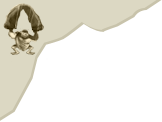

 It seems that the passage between the Lower and Middle Paleolithic in Misliya Cave was accompanied by a technological break. Production of handaxes and side-scrapers on thick flakes, characterizing the Acheulo-Yabrudian was replaced by Levallois and blade technologies in the Early Mousterian. Preliminary observations show that these technologies are absent from the Acheulo - Yabrudian assemblages
It seems that the passage between the Lower and Middle Paleolithic in Misliya Cave was accompanied by a technological break. Production of handaxes and side-scrapers on thick flakes, characterizing the Acheulo-Yabrudian was replaced by Levallois and blade technologies in the Early Mousterian. Preliminary observations show that these technologies are absent from the Acheulo - Yabrudian assemblages in Misliya Cave. This indicates that a cultural discontinuity between the Acheulo - Yabrudian and Mousterian is a more likely scenario, as was previously suggested by other researchers (Bar-Yosef 1998; Goren-Inbar 1995).
in Misliya Cave. This indicates that a cultural discontinuity between the Acheulo - Yabrudian and Mousterian is a more likely scenario, as was previously suggested by other researchers (Bar-Yosef 1998; Goren-Inbar 1995).
 The handaxes from the Lower Terrace were found alongside typical Acheulo - Yabrudian side-scrapers (dejete and transverse side-scrapers, sometimes with Quina retouch) and a limace that have been found in the Levant only in Acheulo - Yabrudian contexts (Gisis and Bar-Yosef 1974; Copeland 1983; Zaidner et al. 2006).
The handaxes from the Lower Terrace were found alongside typical Acheulo - Yabrudian side-scrapers (dejete and transverse side-scrapers, sometimes with Quina retouch) and a limace that have been found in the Levant only in Acheulo - Yabrudian contexts (Gisis and Bar-Yosef 1974; Copeland 1983; Zaidner et al. 2006).

Transverse and Dejete side-scrapers with Quina and semi-Quina retouch.
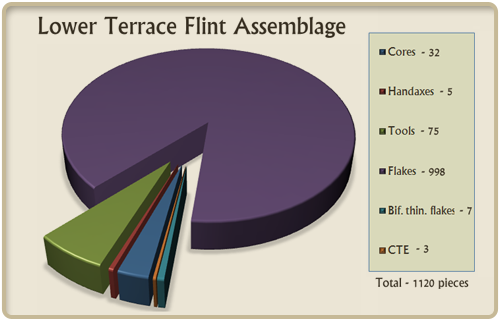
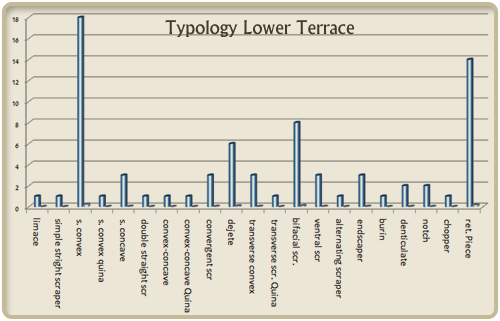
![]()
Acheulo-Yabrudian Handaxes
 As a rule, the prehistoric knapper focused on the shaping of the handaxe tip and not on its entire circumference. In this, the Misliya handaxes differ from other Late Acheulian bifaces that were bifacially flaked all around their circumference. It seems that the function of a piece was of higher importance than its overall symmetry.
As a rule, the prehistoric knapper focused on the shaping of the handaxe tip and not on its entire circumference. In this, the Misliya handaxes differ from other Late Acheulian bifaces that were bifacially flaked all around their circumference. It seems that the function of a piece was of higher importance than its overall symmetry.


Use of different blanks led to the production of different handaxes. The differences are expressed in high values of Roe's tip refinement ratio and the low number of retouched handaxes among handaxes made on flakes or thin nodules compared to those made on indeterminate types of blanks (probably made on thick blocks).



The distinction between handaxes made on flakes, "unifaces" and side-scrapers is unclear. All three types are often morphologically similar. In this regard Misliya Cave closely resembles layer E of Bezez Cave (Copeland 1983).

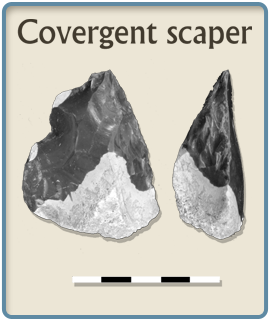
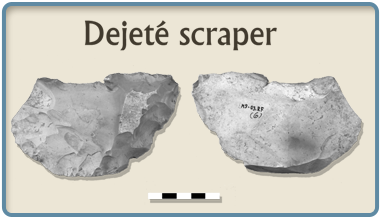
![]()
Mousterian
The Early Mousterian industry was unearthed from ca 20 square meters on the Upper Terrace. The assemblages excavated so far show no temporal or spatial differences in terms of technological or typological characteristics. Yet there are noticeable differences in artifact densities. In the soft sediments area, the density of the artifacts larger than 2.5 cm is about 3000 pieces per cubic meter. Density of the artifacts in brecciated layers is generally lower. The preservation of artifacts is amazingly good as no signs of abrasion were recorded.
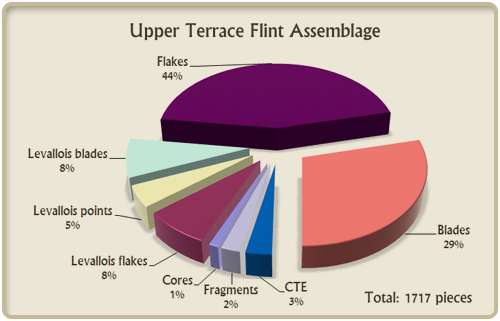
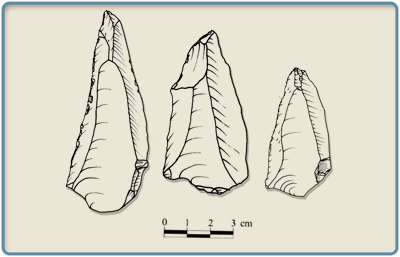 The assemblage is rich in Levallois items, especially elongated Levallois points and blades. The points were generally made by the convergent unipolar method, while blades often were made by the bipolar method. Levallois flakes are less common product. Some of them have a triangular shape, and technologically and morphologically they are very similar to Levallois points.
The assemblage is rich in Levallois items, especially elongated Levallois points and blades. The points were generally made by the convergent unipolar method, while blades often were made by the bipolar method. Levallois flakes are less common product. Some of them have a triangular shape, and technologically and morphologically they are very similar to Levallois points.
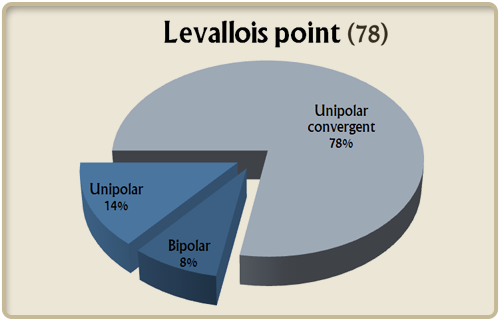
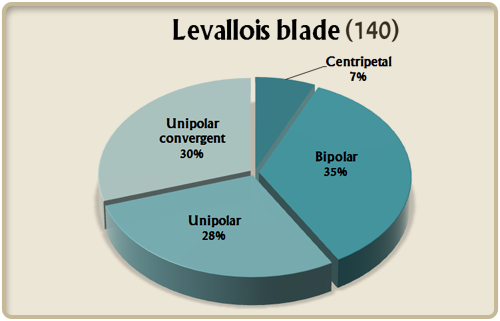
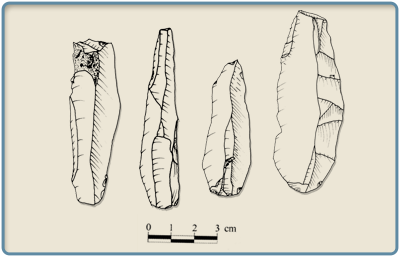 Alongside Levallois methods, non-Levallois laminar technologies are one of the most distinct features of the assemblage. The non-Levallois blades are generally narrower and thicker than Levallois blades and exhibit a triangular cross-section. Crested blades found during the excavation show that one of the methods of blade-cores preparation included narrowing of the flaking surface.
Alongside Levallois methods, non-Levallois laminar technologies are one of the most distinct features of the assemblage. The non-Levallois blades are generally narrower and thicker than Levallois blades and exhibit a triangular cross-section. Crested blades found during the excavation show that one of the methods of blade-cores preparation included narrowing of the flaking surface.
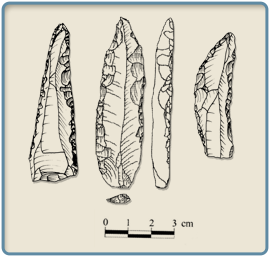
Different retouched tools were made on blades at Misliya Cave. Those include side-scrapers, retouched blades and various types of points. Among them are elongated Mousterian points, Abu Sif points, Hummal points and retouched Levallois points.
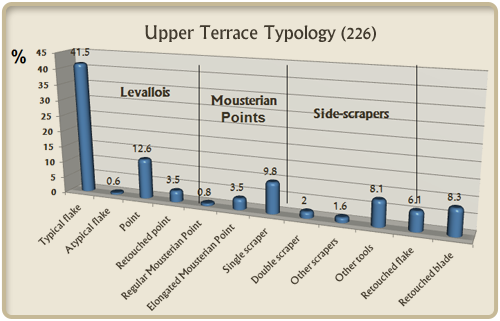
![]()
Raw Material Sources
Flint is the sole rock type used by the Misliya inhabitants in all excavated units. During the work on the lithic assemblages, the sources of flint used at the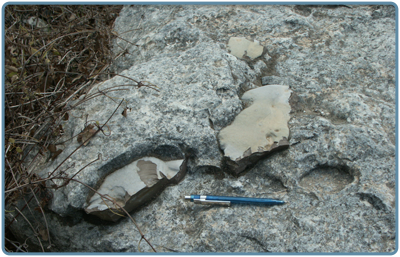 site were identified. Mount Carmel is rich in flints of different qualities and shapes. In Nahal Galim, for example flint appears in the shape of thin nodules excellent for production of handaxes. This type of flint was also used for production of special Levallois core-types.
site were identified. Mount Carmel is rich in flints of different qualities and shapes. In Nahal Galim, for example flint appears in the shape of thin nodules excellent for production of handaxes. This type of flint was also used for production of special Levallois core-types.
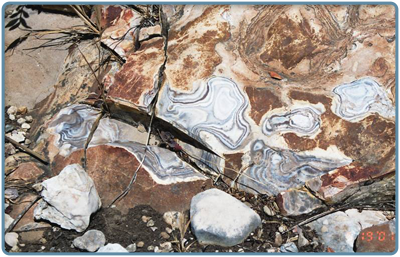 In other sources on Mount Carmel and Ramat Menashe it appears as rounded nodules of different sizes or as large blocks.
In other sources on Mount Carmel and Ramat Menashe it appears as rounded nodules of different sizes or as large blocks.
The flint at Misliya Cave comes mostly from nearby sources (2-5 km distance). Nahal Galim provides probably the best flint on Mount Carmel and it served as the main flint source during both Mousterian and Acheulo-Yabrudian occupations of the site. The most remote among the recognized sources is flint from Ramot Menashe, ca 20 km south of Misliya Cave. This flint appears in the shape of cracked blocks of bad quality. It was rarely used during the Mousterian and more frequently during the Acheulo-Yabrudian, especially for production of handaxes.
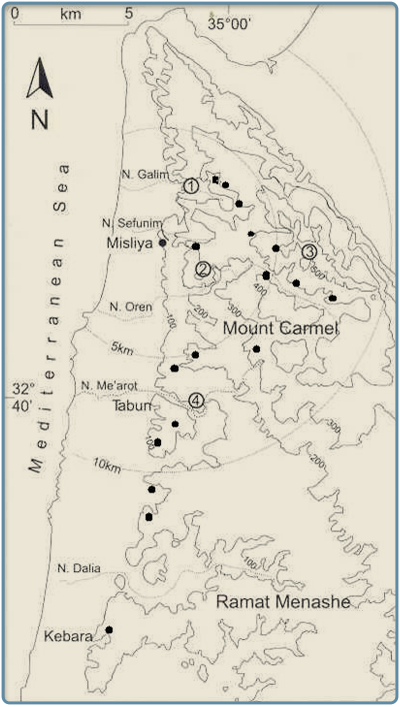 |
The main flint raw-material sources: |
- Bar-Yosef, O., 1998. The chronology of the Middle Paleolithic of the Levant. In: Akazawa, T., Aoki, K., Bar-Yosef, O. (Eds.), Neandertals and Modern Humans in Western Asia. Plenum Press, New York, pp. 39-56.
- Copeland, L., 1983. The Paleolithic stone industries. In: Roe, D. (Ed.), Adlun in the Stone Age: The excavations of D. A. E. Garrod in the Lebanon 1958-1963. BAR IS 159, Oxford, pp. 89-365.
- Gisis, I., Bar-Yosef, O., 1974. New excavations in Zuttiyeh Cave, Wadi Amud, Israel. Paléorient 2: 175-180.
- Goren-Inbar, N., 1995. The Lower Paleolithic of Israel. In: Levy T. (Ed.), The Archaeology of Society in the Holy Land. Leicester University Press, London, pp. 93-109.
- Zaidner, Y. Druck, D. Nadler, M. And Weinstein-Evron, M. 2005. The Acheulo-Yabrudian Of Jamal Cave, Mount Carmel, Israel. Journal of the Israel Prehistoric Society 35: 93-116.
